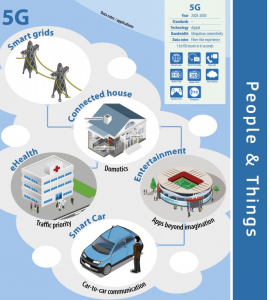 The 4G technology has already become accessible to the common man. The UK saw its first, belated, 4G network appear for use in late 2012, which managed to wangle approval from regulator Ofcom to launch an LTE service before the other main providers. Since then Vodafone and O2 have launched their new high-speed 4G networks and three has joined the party in rolling out a 4G network. With the new 4G network launch, smartphone now gives customer quicker uploads and downloads than your home broadband.
The 4G technology has already become accessible to the common man. The UK saw its first, belated, 4G network appear for use in late 2012, which managed to wangle approval from regulator Ofcom to launch an LTE service before the other main providers. Since then Vodafone and O2 have launched their new high-speed 4G networks and three has joined the party in rolling out a 4G network. With the new 4G network launch, smartphone now gives customer quicker uploads and downloads than your home broadband.
The question arises here is ‘Where will 4G go next, and what exactly is 5G?. According to a press release by Telecom Regulatory Authority of India (TRAI), the number of mobile phone subscribers in the country has crossed 952.34 million, as of January 2015, and is continuously growing.
The Voice over LTE (VoLTE) scheme was devised as a result of operators seeking a standardised system for transferring traffic for voice over long term evolution (LTE.) Originally LTE was seen as a completely IP cellular system just for carrying data, and operators would be able to carry voice either by reverting to 2G/3G systems or by using voice over Internet protocol (VoIP) in one form or another.
Vodafone and advertising firm JCDecaux signed an agreement for a global small cell rollout a few months back. Small cells basically take mobile signals transmitted by macrocells and direct these to mobile transceiver units within a range of 10 to several hundred metres, and vice versa. These have gained much importance in LTE era and are usually deployed both outdoors and indoors, where signals are weak or networks are overloaded.
Now if we talk about the fifth generation of mobile communication (5G network) then its already in development phase around the world. 5G denotes the next major phase of mobile telecommunications standards beyond the current 4G/IMT-Advanced standards.
Next generation mobile networks alliance feel that 5G should be rolled out by 2020 to meet business and consumer demands. In addition to simply providing faster speeds, they predict that 5G networks will also need to meet the needs of new use-cases such as the Internet of Things (IoT) as well as broadcast-like services and lifeline communications in times of natural disaster. To achieve these demands, 5G networks will need to adopt new technologies such as mesh networking, whereby devices communicate with each other directly rather than relying on network operators’ base stations. This will increase the bandwidth available, lower power consumption, reduce infrastructure costs, improve spectral efficiency and increase the resilience of the network, but could also lead to higher latencies.
Since many mobile phone users in India still use GSM (Global System for Mobile communication) and 2G technology, it will take a while to adopt 4G and 5G; an overlap period of these technologies is expected to be high. This is why a rollout plan having flexible hardware with backward compatibility to legacy technologies is a prime requirement for the implementation of new wireless standards.
Jayanth Ramachandran, business development head – telecom, Rohde & Schwarz India shared with EFY, “One of the biggest concerns for implementing 5G technology would be the uncertainty of the propagation model at higher frequency bands, which are being planned to be used. The end user experience depends on what kind of bandwidth is available.”
White spaces which refers to the unlicensed frequencies in the spectrum allocated to broadcasting services, has started spreading internet access to unconnected areas. White Space stands to transform the way we purchase and use wireless internet. It isn’t yet widely adopted, but this unlicensed, free form of broadband is gaining traction. The average white space in the ultra high frequency (UHF) television band in India is above 100MHz (as per quantitative assessment of television white space in India by Gaurang Naik, Sudesh Singhal, Animesh Kumar and Abhay Karandikar, IIT Bombay.)
Every year something big is happening in the mobile sector, a new generation of mobile network technology comes along. 3G was meant to sort out GSM’s lack of mobile data and, given it didn’t much succeed, 4G was needed to finally make consuming data less of an unpleasant experience. Now its time for 5G which is going to be the next big thing to hit mobile communication and can be expected to reach the market in another five years.






